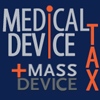
The 2.3% medical device excise tax appears simple, but tax experts are advising med-tech clients that implementing the levy will be more complex and time-consuming than most think.
Zara Muradali, a managing director in the federal tax practice at multi-national accounting, tax and advisory firm KPMG, told MassDevice that she is advising her clients to have their ducks in a row by the end of the 3rd quarter in order to prepare for the impact of the tax.
The medical device tax will go into effect on January 1, 2013, with the 1st checks to the federal government due on January 29 – not a lot of time when you consider that the excise tax will be applied to every sale rather than to overall sales.
“From what I see, it takes 6 months to really implement the tax,” she told us. “This is truly a cross-functional approach because this is not a tax issue only. Tax departments will have to work with their IT counterparts to make sure there’s a system in place to even be able to identify from a product-by-product and line item basis, to figure out how they will determine the tax.”
The device tax, which became law nearly 2 years ago as part of the Patient Protection & Affordable Care Act, is expected to net some $2 billion a year in order to pay for certain provisions of the landmark health care law. The bulk of those funds will come from large companies such as Medtronic (NYSE:MDT),which will fork over somewhere between $125-$175 million in 2013, according to estimates.
The Internal Revenue Service is expected to administer the tax. However, Muradali said that there is still some ambiguity for medical device companies with regard to the constructive sales rule, or to the point at which point the tax should be levied. She pointed out that medical device companies have multiple units in the manufacturing process and determining where an actual sale occurs still isn’t clear. For example, a medical device manufacturer may have several of its products outsourced to engineering and design firms during the manufacturing process.
The IRS has released a public guidance document to try to determine where the excise tax will be levied. However, Muradali said that "this is something with which companies will have to wrestle.”
Muradali suggested that contract manufacturers closely review their contracts with med-tech companies to perform a risks-versus-rights analysis, paying attention to specifically who in the chain of manufacturing has the risk, that will be the company, which mostly likely bears the burden of the tax.
KPMG is encouraging med-tech companies it works with with to follow an 8-step process.
“We’re really trying to impress upon clients that this isn’t something you can just ask in Q&A session, ‘Is this taxable? Is this product taxable or not?’ You really have to understand the organization background, what the manufacturing activity is, what the supply chain is and finally, you have understand the transactions and which transactions are exempt from this tax.”
Muradali’s top 3 tips for the medical device companies dealing with the new tax:
- "1st, companies need to understand that this is here to stay, so do a gap analysis to identify the areas which need to be addressed as soon as possible."
- "2nd, get up to speed from a technical perspective. There are a lot of exemptions and a lot of new information out there. It’s hard to get up to speed on your own. The education process and speaking to colleagues in the same industry is critical."
- "3rd, implement processes early. Don’t wait for the very end. You want to be ready by the 3rd quarter. You don’t want to be surprised in the last quarter of the year."

